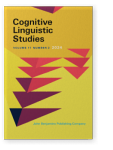Vol. 11:2 (2024) ► pp.297–334
The interface between body and culture in the figurative conceptualization of the “eye” in Amharic
Inspired by the notions of body-based and culturally specific embodiment, this study sheds light on the interface between body and culture in the Amharic conceptualization of ayn ‘eye.’ Applying the “lexical approach”, we examine the eye-related metaphors in Amharic monolingual and bilingual dictionaries. At the bodily level, the widespread conceptual metaphors knowing/thinking is seeing and eyes are light sources, and the metonymies eye for person and physiological (eye) change stands for an emotion are present in Amharic. At the cultural dimension, ayn is related to the concept of the “evil eye”, which associates the eye with mystical powers. However, contrary to the widespread superstitious belief of the “evil eye” in other cultures, the notion of the “evil eye” in Amharic is associated with the concept of buda – a class of people socially segregated due to their economic status and their accursed lineage. Our study shows that the presence of similar conceptual metaphors (“vision-light”, “vision-knowledge”, and “eye-emotion/personality” metaphors) and cultural beliefs (the “evil eye”) in different languages/cultures does not necessarily entail equal conceptualization.
Article outline
- 1.Introduction
- 2.Literature review
- 3.Methodology
- 3.1Data selection
- 3.2Data analysis
- 4.Findings
- 4.1Eye as the organ of sight
- 4.2
eye for person
- 4.2.1Eyes as the most distinctive part of the person
- 4.3Eye as the locus of the intellect
- 4.4Eyes as the loci of emotions and characters
- 4.5The cultural conceptualization of eye: Buda, the “evil eye” people
- 5.Discussion
- 6.Conclusion
- Notes
- Abbreviations
- Author queries
-
References -
Dictionaries
